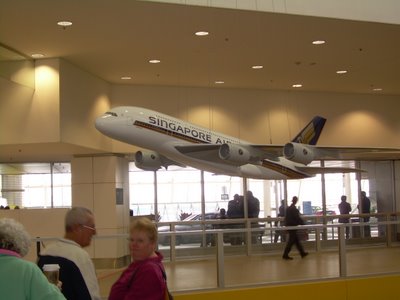Big Ideas

Relating to the emperor's new clothes, just because most people support an idea does not mean it is a good one. This model hanging at Sydney's airport is as close as we will get to an A-380 for a while. The world's largest airliner will carry around 600 passengers. Originally they were supposed to be flying across the Pacific this year. With all the delays they will not carry any passengers until at least 2008.
The big plane was launched with great fanfare and an initial order from Federal Express. A super-jumbo has been studied for years, with American planemakers like Boeing deciding it would not be profitable. Airbus has discovered the hard way that simply scaling a plane up creates big problems. Among other things, the French and German divisions of Airbus use incompatible CAD systems. Since the 777 every airliner has been designed with CAD. This has led to big problems laying out the wiring, costing Airbus at least 6 billion dollars. Their last CEO resigned after just 2 months on the job.
In the meantime, Boeing has quietly designed a more advanced aircraft. The 787 will be built mostly from composites. Instead of the fuselage being built from metal panels, it will be formed in one piece like a plastic tube. Because of light weight and advanced engines, the 787 will have better gas mileage than any competitor, a big selling point these days. Boeing has sold more than 400 of the new planes, so many they can not keep up with the orders. The smaller plane will be far more successful than the big one.
At Federal Express it absolutely positively has to get there on time. This week Fedex cancelled their order of A-380's and switched to Boeing planes. At a relatively low cost, Boeing has used their new technology to design an bigger version of the 747. The new 747-8 will also be attractive to airlines because pilots will not have to learn an entirely different aircraft.
For decades there has been a fad for "big science." Physicists have enjoyed free rein to build bigger machines and bigger collaborations. That is why you see papers published with dozens of authors. As Lee Smolin, Peter Woit and even Sean Carroll have noted, that has led to few great discoveries in the past 30 years. Big science has led to a point of diminishing returns. Today a single determined researcher can achieve something "far simpler, more important and more testable than anything that Sean Carroll or any of his colleagues have ever invented in decades if not centuries of their fruitless and expensive efforts." (Those last kind words came from none other than Lubos Motl.)



4 Comments:
Heh, Louise. Are you in Sydney then?
HI Kea. I passed through Sydney, so am always interested in better ways of getting across the ocean. One day I will do a post on hypersonic aircraft to make the trip in an hour or two.
Dear Rio Frio,
I am happy that you have enjoyed the compliment but I hope that you also realize that it was a joke, as pretty clearly indicated in the article. ;-)
Despite all my reservations towards Sean, I think their work is more solid and important than T=M in Planck units. Returns may be diminishing but because we don't have a time machine, we can only compare directions that are meaningful at this moment, the same moment, rather than comparing competitors from different eras of history.
Concerning pigs etc. in my quote, I agree with the Princeton guys in the 1950s who thought that women may be distracting in the physics departments, which is not necessarily just a bad thing.
Best wishes
Firefly
kobe byrant shoes
ferragamo belts
jordan 4
af1
michael kors handbags
nike lebron soldier 11
goyard handbags
adidas tubular
kobe shoes
Post a Comment
<< Home